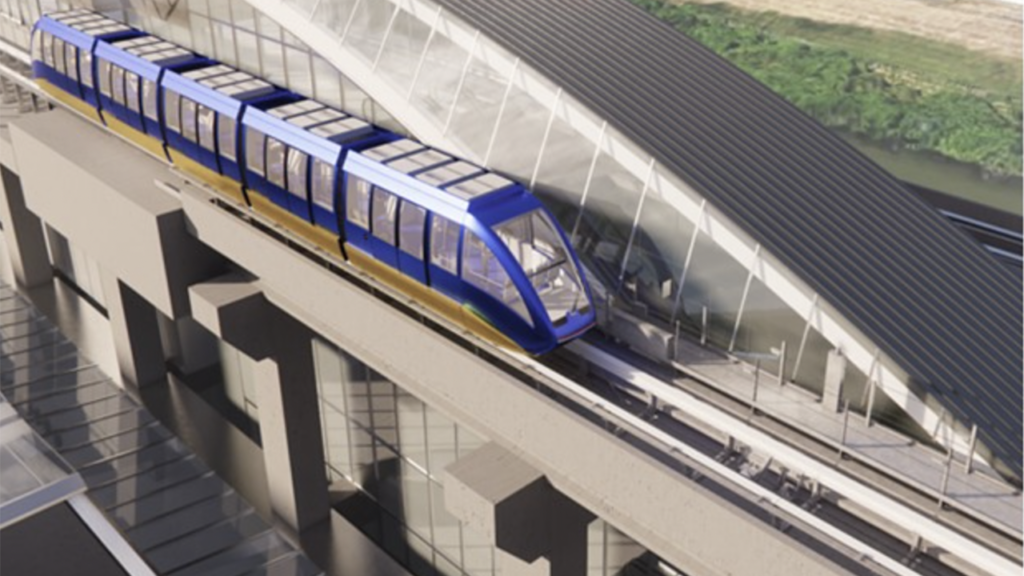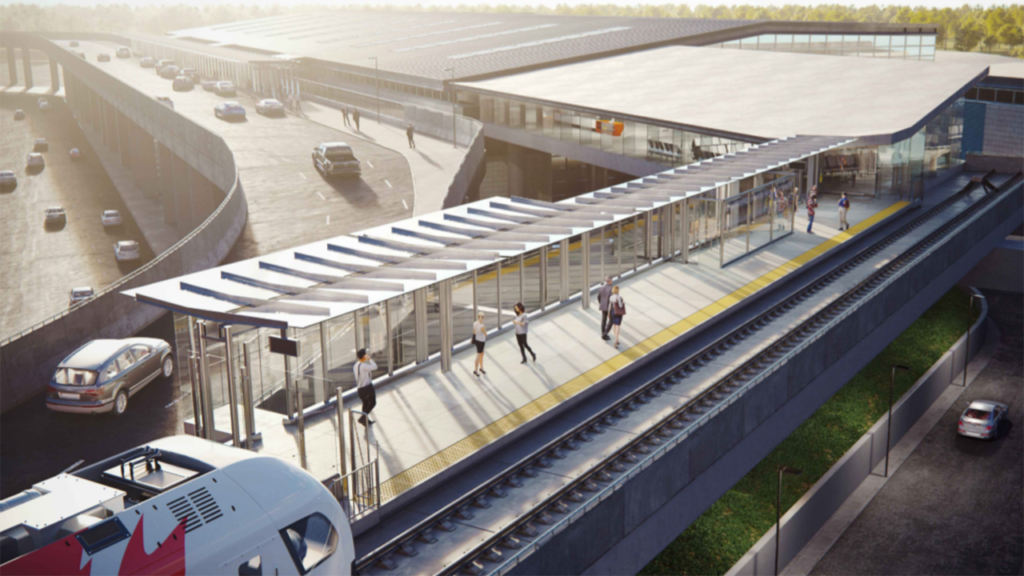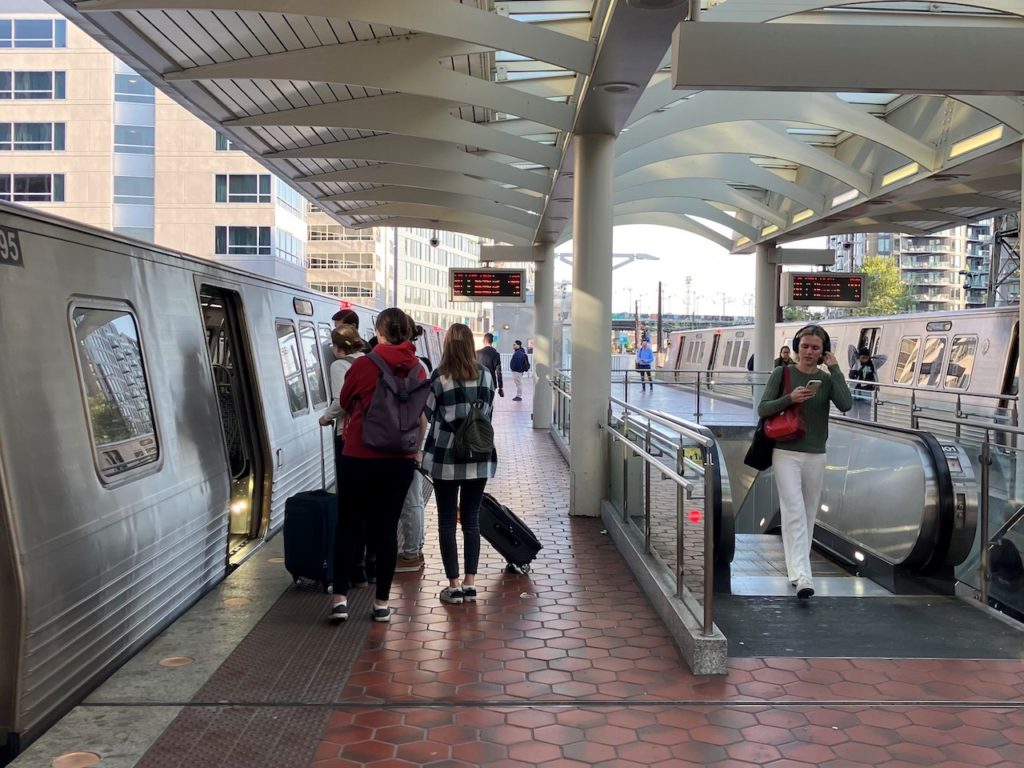
Transit Briefs: Amtrak, PANY/NJ, Trillium Line, U.S. Government
Written by Marybeth Luczak, Executive Editor
In January, Amtrak will award 11 scholarships to help full-time undergraduate and graduate students interested in rail. (Amtrak Photograph)
Amtrak is seeking applicants for its scholarship program. Also, Port Authority of New York and New Jersey (PANY/NJ) approves its 2024 budget that advances a new PATH fare payment system and the development of a new AirTrain Newark system, and awards a design and construction contract for AirTrain Newark; the DMU Trillium Line’s hand-over to the city of Ottawa, Ontario, has been delayed again; and U.S. government workers on official business will soon have to prioritize taking public transit.
Amtrak
Amtrak will award 11 scholarships to help full-time undergraduate and graduate students interested in rail. Applications are due by Jan. 31, 2024, at 11:59 p.m. ET.
The Amtrak Scholarship Program “aims to encourage innovative ideas and fuel the future of rail,” “America’s Railroad” reported Dec. 14. Its scholarships include:
- Women in STEM, for students identifying as women pursuing an undergraduate or master’s degree majoring in science, technology, engineering or math.
- Engineering, for students with an interest in rail engineering.
- IT, for students in information technology, computer science or a similar field.
- Non-Technical, for students in business, finance, marketing, supply chain or a similar field.
- Philip Randolph, for children, spouses, civil union partners, or domestic partners of Amtrak employees, retirees, or furloughed employees.
Three additional Amtrak scholarships that align with and are co-sponsored by Amtrak Employee Resource Groups (ERGs) will also be awarded to high school seniors “who have been profoundly influenced by their experiences with the Hispanic/Latinx, Black/African American, or Asian American/Pacific Islander communities,” Amtrak said.
Scholarships will help full time students with tuition, fees, books, and/or equipment, according to Amtrak, which noted that candidates are encouraged to submit more than one application.
PANY/NJ
The PANY/NJ Board of Commissioners on Dec. 14 approved the agency’s $9.3 billion 2024 budget, which consists of $3.9 billion in operating expenses, $3.6 billion in capital expenses, and $1.8 billion for debt service and deferred expenses. It is said to reflect “a return to pre-COVID spending levels following several years of reduced spending due to the COVID-19 pandemic.” (While the final budget document and supporting schedules will be available upon completion of the gubernatorial review period, see the proposed budget above, which was released Nov. 15 for public comment.)
According to PANY/NJ, the $3.6 billion capital budget will support these rail-related projects:
- Replacement of PATH’s current fare collection system with a modern “tap-and-go” system.
- Development of a new AirTrain Newark system to replace the current outmoded system serving Newark Liberty International Airport, as well as advancement of the EWR Station access project that will expand rail and airport access for underserved Newark and Elizabeth communities.
The agency reported that $66 million of “special purpose spending is necessary for incremental costs associated with new or expanded facilities, required security investments, new PATH system state of good repair work, and operational investments.”
Additionally, automatic inflation-based adjustments are scheduled for implementation at the bridges and tunnels on Jan. 7, 2024, and at AirTrain rail systems on March 3, 2024, as established by three resolutions of the Port Authority’s Board of Commissioners (2008, 2011, 2019). From September 2022 through September 2023, the consumer price index increased 3.7%, which triggered an annual automatic inflation-based bridge and tunnel toll adjustment of $0.63, as well as an AirTrain fare increase of $0.25, PANY/NJ said.
Fares at PATH will remain at their current level. Discount bridge and tunnel toll and AirTrain fare plans will continue.
“With travel activity rebounding across the region, we are returning to pre-COVID spending levels and aggressively moving ahead on a multitude of substantial projects,” PANY/NJ Executive Director Rick Cotton said. “Everyone who makes use of Port Authority facilities, from travelers at our airports and truckers at our seaport, to bus riders and PATH passengers, will see funding set aside to improve their experience in this spending plan.”

Separately, PANY/NJ on Dec. 14 reported selecting Doppelmayr in the first phase of a multi-phase procurement process to replace Newark Liberty International Airport’s AirTrain system, which opened in 1996. The AirTrain Newark Replacement Program will provide a “modern, reliable 2.5-mile automated people mover train system,” the agency said. Doppelmayr’s contract includes $570 million for design and construction, with an estimated $385 million over 20 years, net present value, for operation and maintenance of the automated people mover system and its vehicles.
Doppelmayr was selected following a Request for Qualifications issued in December 2022 and a Request for Proposals issued in March 2023. The new AirTrain system is expected to open in 2029, according to PANY/NJ.
“Doppelmayr is proud to partner with PANY/NJ for the development of the new AirTrain Newark,” said Markus Schrenttewein, President of Doppelmayr Cable Car America, Inc. “The Doppelmayr Group has a large number of similar projects to its name in the U.S., namely the Oakland Airport Connector and systems in Las Vegas. For AirTrain Newark, Doppelmayr will place a special emphasis on creating value for the local community.”
According to PANY/NJ, the first procurement phase also includes the furnishing, delivery, installation, testing and commissioning of the system technology components, which include train control, electrical power, communications, propulsion, and Maintenance and Control Facility (MCF) equipment. Future project procurement phases will include contracts related to the system’s guideway and stations, maintenance and control facility, pedestrian connections, and demolition of the existing system, among others.
AirTrain Newark serves as the primary means for millions of people to transfer between the three passenger terminals at Newark Liberty, parking, rental car facilities, and regional rail transit via the Northeast Corridor Rail Link Station, with connections to New Jersey Transit commuter rail and Amtrak intercity passenger rail services. Before the COVID-19 pandemic, AirTrain carried an average of 33,000 riders per day, or approximately 12 million riders per year, according to PANY/NJ.
Trillium Line

Delays continue for the north-south DMU Trillium Line. The city of Ottawa is now expected to take control of it in June 2024, according to a Ottawa Citizen report of the city’s Dec. 14 Transit Commission meeting. The General Manager of the City’s Transit Services Department, Renée Amilcar, had said in the fall that the hand-over would take place in April 2024.
The DMU Trillium Line comprises Line 2 from Bayview to Limebank stations and Line 4 from South Keys to the Ottawa airport. “The original contract called for it to be ready in the summer of 2022, while last winter … [it was expected to be] ready for service for the 2023-24 school year,” the newspaper said.
Ottawa Director of Rail Construction Michael Morgan provided a progress report on the line at the Transit Commission meeting. The DMU Trillium line will run Alstom and Stadler diesel trains, he said, which “have already begun testing runs on the track,” according to the Ottawa Citizen. Additionally, the first four classes of operators finished training and the second class will start soon, the paper said.
Michael Morgan also reported on the Confederation Line’s West Light Rail Transit Extension and East Light Rail Transit Extension. The completion date for the eastward extension “to Trim Road has slipped another 60 days,” the newspaper reported. “The first test trains are expected to roll on the eastward line around the end of January 2024, with full revenue service on track for late spring 2025, Morgan said. The westward extension to Algonquin College and Moodie Drive isn’t expected to be complete until late 2026.”
For background on the projects, read: “Ottawa LRT Projects Advancing,” a report by Railway Age Canadian Contributing Editor John Thompson.
U.S. Government

“Workers on official business will have to prioritize taking public transit, renting electric vehicles or even riding bikes under a new memorandum from the Office of Management and Budget [OMB] and a General Services Administration [GSA] bulletin that updated the Federal Travel Regulation,” Government Executive reported Dec. 14. “Agencies should also consider not sending employees on business trips at all, with GSA noting, ‘In every case, the trip not taken is the least expensive and most sustainable.’” The memorandum and bulletin stem from a 2021 Executive Order from President Biden and are slated to “supplement existing policies, with OMB instructing agencies to update their regulations as applicable,” the magazine said. “The White House said federal employees will be ‘leading by example on climate.’”
According to the Government Executive report, $2.8 billion is spent on official government travel each year, with 2.8 million flights taken and 2.3 million cars rented by employees.
“When agencies determine employees must still travel—rather than taking advantage of virtual options, as preferred under the new guidance—they should consider rail options, particularly in the Northeast, Mid-Atlantic, internationally and between cities less than 250 miles apart,” the magazine said. “Federal employees take just 33,000 train trips on official business annually. Otherwise, they should drive using a government-owned EV if possible. Once in their temporary duty location, employees should use public transportation as their first option.”
According to the magazine report, “‘[t]ravelers should be familiar with subway/trains and bus routes that are available between meetings, lodging and other locations at which business is to be conducted,’ GSA said. ‘When available, employees should use public buses that use alternative fuels, such as electricity or compressed natural gas, rather than gasoline or diesel to reduce [greenhouse gas] emissions.’”
Employees who must rent cars should choose an EV “if it is the same price or cheaper than other allowable options,” Government Executive reported. “OMB and GSA clarified that charging costs can be expensed as fuel. If no EV fits the existing parameters, employees should then prioritize renting a hybrid vehicle, followed by a compact car. Employees should use ‘green’ options on rideshare apps such as Lyft and Uber and consider the feasibility of bike shares. Agencies should ensure their staff combine travel whenever possible, including by requiring multiple legs, and instruct employees to share rides with their coworkers.”
According to the magazine, OMB directed GSA “to develop and submit within 120 days a strategic plan for sustainable aviation, which should, for example, include examining whether to require airlines to submit information on their fuel usage and operational efficiency.”
Additionally, the White House called on agencies “to change the default on their travel systems to display sustainable options first and which hotels have charging stations. They should train appropriate employees on sustainable travel policies, OMB said, and report back on progress within 120 days. Procurement officials should work with vendors to make sustainable travel options easier to select, update agency rental agreements and look into negotiating rates for charging vehicles.”



